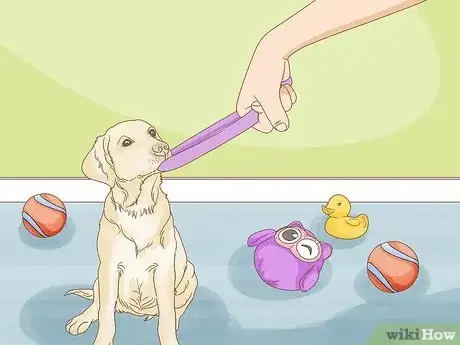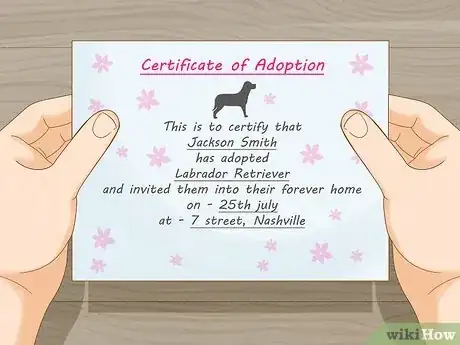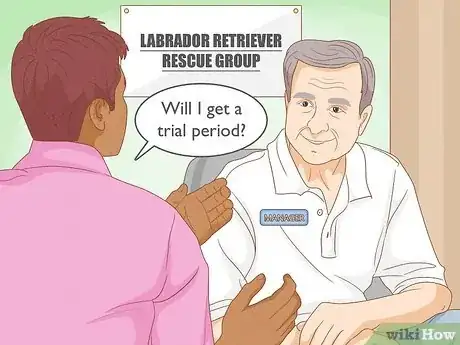This article was co-authored by Cameron Thompsen. Cameron Thompsen is a Dog Trainer and Human Coach, as well as the Owner and Founder of Hope2K9 Foundation. With nearly two decades of experience, she specializes in working with dogs and their owners on behavior issues ranging from severe anxiety, reactivity, as well as aggression and fear-based problems. She works with all dogs at Hope2K9 so that they are fully trained before adoption, and provides lifelong support to dog owners after adoption.
There are 12 references cited in this article, which can be found at the bottom of the page.
wikiHow marks an article as reader-approved once it receives enough positive feedback. In this case, several readers have written to tell us that this article was helpful to them, earning it our reader-approved status.
This article has been viewed 127,262 times.
If you're looking to add a smart, adorable, and super friendly dog to your household, then a labrador is a great choice! These pups make amazing pets—but how can you be sure you're selecting the perfect puppy to add to your family? Don't worry, we've got you covered. We'll help you decide what you want in a dog, and then we'll explain how to adopt or buy from a breeder. To learn everything you need to know about how to select a lab, read on!
Steps
Thinking About What You Want in a Labrador
-
1Decide if your personality and lifestyle will be a good fit for a Lab. Labs crave company and stimulation, so it is important for you to spend lots of time with your Lab and to invest time and energy in training your Lab.[1] Be honest with yourself about how much time and energy you will be able to invest in your dog.
- Think about your how much time you spend away from home. If you are often not home due to work or other lifestyle factors, then a Lab may not be the ideal pet for you.[2]
- Determine whether you are willing and able to train a dog. Labs are easy to train and they enjoy the stimulation. Before you decide to get a dog, think realistically about how much time you will be able to devote to training your Lab.[3] If you do not plan to train your dog due to time or energy constraints, then a dog may not be the best choice.[4]
- Consider other lifestyle factors. Labs are great with kids and other pets as well, so a Lab may be a good fit if you have kids and/or other pets.[5]
-
2Decide if you have the time and energy for a Lab puppy. Puppies are hard to train and they require lots of time as well. Before you decide to get a puppy, think about your lifestyle and the amount of time that you can devote to raising a puppy.[6]
- For example, will you be willing to get woken up every couple of hours in the middle of the night if your puppy is crying? Will you be able to manage if your puppy chews up one of your favorite pairs of shoes? Are you willing to clean up urine and feces accidents during the housetraining process? If not, then consider adopting an adult dog.[7]
- On the other hand, there are some positives to getting a puppy. Training your Labrador from a young age creates a fantastic bond between the two of you and you will get to enjoy watching your pet grow and mature.
Advertisement -
3Think about adopting an adult Lab. Some of the positives of taking on an adult dog is that they are often already house broken and may even know some basic commands, such as sit and stay. Therefore, if you don't have the time or desire to housetrain a dog, then adopting an adult could be the best option for you.[8]
- One potential downside of an adult dog is he may not be trained, and adult dogs may be harder to train. Also, some dogs may not have been well-socialized and may get spooked by certain things such as other dogs, strangers, etc. Consider whether you have the necessary training skills to correct these problems should you encounter them.[9]
-
4Decide whether to get a male or female Lab. Gender is not a big deal unless you already have a dog. If you own a dog already, then getting a dog of the opposite gender will provide the best chance of harmony between your pets.[10]
- Male dogs tend to be a bit more aggressive, but these behaviors can be controlled with training.
- Female dogs often more easygoing, but Labs are such a relaxed breed that this doesn't really matter too much.
- Regardless of the gender of your dog, make sure that you spay or neuter the dog unless you intend to breed it.
-
5Identify what the dog’s role will be. The Labrador’s willingness to please makes them easy to train and they make great working dogs. They have many roles in society, ranging from their origins as gun dogs retrieving game, to assistance dogs for the visually impaired.
- If you are looking for certain characteristics in a dog for working purposes, then be sure to source a purebred dog from a breeder who raises dogs with the characteristics you require.[11]
-
6Select a color. The most common Lab colors are black, yellow, and chocolate. All colors of Labradors are easy to train, but chocolate Labradors do have a reputation for being more disobedient than their yellow or black cousins. However, there is much debate among breeders and Lab owners about this reputation.[12]
- Keep in mind that all dogs have different personalities and abilities regardless of color, so color choice is more about your personal preference than anything else.[13]
Adopting a Labrador
-
1Consider adopting a Lab. Adopting a Lab from a shelter or rescue group is a great thing to do, as these dogs are often loving, loyal animals who through no fault of their own have ended up in a rescue. Just keep in mind that adopting a Lab can mean compromising on little things such as the dog’s color, age, or gender.[14]
-
2Look into a breed-specific Labrador retriever rescue group. Most dog breeds have fans who work to ensure that special dog breeds, such as Labradors, have good homes. Check to see if there are any Labrador rescue groups in your area with dogs available for adoption.
- You may be able to get contact information for local rescue organizations from your local humane society, veterinarian's office, or pet shop.
- Keep in mind that dogs who end up in rescue programs are not there because they are bad. Owners may give up their dogs because of life circumstances such as a divorce, job loss, or physical condition. Other times a dog may end up in a rescue program because the owner did not fully consider the financial and/or time commitment that a dog requires.[15]
-
3Ask about a trial period. If you are nervous about adopting a dog, keep in mind that many adoption agencies offer or even require a trial period for qualified adopters. During the trial period, you will be able to take the dog home for a week to see if you are a good match for each other.[16]
- Even if you do not have to or want to do a trial period, it is important to meet your potential new pet. Spend some time with him or her before you decide if this is the dog for you. Shelters often have special areas for prospective pet owners and their family members (people and pets) to get to know a potential new member.
Using a Breeder
-
1Use a responsible breeder if you decide to purchase a Lab. It is important to find a responsible breeder in order to get a healthy, well-socialized Lab. By seeking out a responsible breeder, you can also avoid supporting breeders who do not take good care of their dogs. You can find a responsible breeder by checking with your local American Kennel Club.[17]
- Try searching the AKC directory for a responsible breeder in your area: https://www.apps.akc.org/apps/clubs/search/index.cfm
-
2Request to see the puppies with their mother. If you decide to go through a breeder, make sure that you visit the breeder and see the pups with the mother. Never buy a puppy if you are not allowed to see the mother, no matter what the excuse. Puppy mills separate puppies from the mother at a young age, so she doesn’t get to nurse them and so that she can get pregnant again.[18]
- Young pups without a mother are a strong indication that you are dealing with a puppy mill. Do not encourage this immoral trade by purchasing their pups.
-
3Meet with the Lab breeder in person. It is a good idea to visit a few different local breeders before deciding who you want to buy your puppy from. Do not buy a puppy from the first breeder you visit. You may even want to expand your search outside of your own local area in order to find the best breeder and puppy for your needs.[19]
- Never buy from a breeder online without visiting the breeder’s location. If a breeder does not allow you to visit and wants to meet up somewhere else, then this should be a red flag to stay away from this breeder.
- Never have a puppy shipped. Shipping puppies is very stressful on them and often results in a sick, frightened puppy when you pick them up from the airport.
-
4Meet your potential puppy. It is a good idea to get to know your potential puppy before you commit. If the breeder does not want you to meet the dog before you commit to buying it, then that should be a warning sign that something is wrong.[20]
- See how the Lab reacts to you. Try some basic commands see how he responds. See if the puppy is curious and comes to investigate (this is a good sign) or if he cowers in a corner (this is a sign of timidity). Watch how he interacts with the other puppies as well. He should seem playful and energetic.[21]
-
5Look for signs of good health. A puppy that has been raised by a responsible breeder will seem healthy, energetic, and well-fed. If the puppy seems lethargic, malnourished, or has other signs of illness like a runny nose, cough, or skin sores, then that will indicate that the puppy is in poor health. Do not purchase a puppy from this breeder.[22]
-
6Review the Lab's health records. The breeder should be willing to show you the dog’s health records including all immunizations, clearances, and guarantees. If you are getting your dog from a breeder, ask to see the papers for the mother and father of the puppy.
- Be aware that Labradors are prone to a number of hereditary diseases which are passed down along the generations. Responsible breeders will try to eliminate these diseases, which involves the breeder submitting their breeding stock to genetic tests and radiographs to work out if they are carriers or at risk of transmitting, certain conditions.
- Keep in mind that these tests cost the breeder money, so you will need to pay more for a puppy from screened parents. The payback is that the puppy is less likely to develop serious conditions such as hip dysplasia, elbow dysplasia, or eyesight problems.[23]
Expert Q&A
-
QuestionIs a golden retriever the same as a Labrador?
 Pippa Elliott, MRCVSDr. Elliott, BVMS, MRCVS is a veterinarian with over 30 years of experience in veterinary surgery and companion animal practice. She graduated from the University of Glasgow in 1987 with a degree in veterinary medicine and surgery. She has worked at the same animal clinic in her hometown for over 20 years.
Pippa Elliott, MRCVSDr. Elliott, BVMS, MRCVS is a veterinarian with over 30 years of experience in veterinary surgery and companion animal practice. She graduated from the University of Glasgow in 1987 with a degree in veterinary medicine and surgery. She has worked at the same animal clinic in her hometown for over 20 years.
Veterinarian It's true both breeds have the word "retriever" in their name, but they are separate dog breeds. The retriever part comes from the job they were trained to do (retrieving) but they have different characters and different coat types. For example, Labrador retrievers always have a smooth short coat, whereas Golden retrievers have a silky longer coat.
It's true both breeds have the word "retriever" in their name, but they are separate dog breeds. The retriever part comes from the job they were trained to do (retrieving) but they have different characters and different coat types. For example, Labrador retrievers always have a smooth short coat, whereas Golden retrievers have a silky longer coat. -
QuestionWhat are the colors of Labrador Retrievers?
 Pippa Elliott, MRCVSDr. Elliott, BVMS, MRCVS is a veterinarian with over 30 years of experience in veterinary surgery and companion animal practice. She graduated from the University of Glasgow in 1987 with a degree in veterinary medicine and surgery. She has worked at the same animal clinic in her hometown for over 20 years.
Pippa Elliott, MRCVSDr. Elliott, BVMS, MRCVS is a veterinarian with over 30 years of experience in veterinary surgery and companion animal practice. She graduated from the University of Glasgow in 1987 with a degree in veterinary medicine and surgery. She has worked at the same animal clinic in her hometown for over 20 years.
Veterinarian Originally, Labradors were mainly either yellow or black, which were the most popular colors with hunters. Then the rise in popularity of Labs as pets led to a rise in the number of chocolate Labs. Recently, even more unusual colors have crept in, such as fox red or silver.
Originally, Labradors were mainly either yellow or black, which were the most popular colors with hunters. Then the rise in popularity of Labs as pets led to a rise in the number of chocolate Labs. Recently, even more unusual colors have crept in, such as fox red or silver. -
QuestionWhich color lab is the best?
 Pippa Elliott, MRCVSDr. Elliott, BVMS, MRCVS is a veterinarian with over 30 years of experience in veterinary surgery and companion animal practice. She graduated from the University of Glasgow in 1987 with a degree in veterinary medicine and surgery. She has worked at the same animal clinic in her hometown for over 20 years.
Pippa Elliott, MRCVSDr. Elliott, BVMS, MRCVS is a veterinarian with over 30 years of experience in veterinary surgery and companion animal practice. She graduated from the University of Glasgow in 1987 with a degree in veterinary medicine and surgery. She has worked at the same animal clinic in her hometown for over 20 years.
Veterinarian There is a lot of debate about whether different color labradors have different characteristics. Traditionally, yellow and black labs were working dogs, so they are often more obedient than chocolate labs. Chocolate labs appeared later in response to demand from the pet trade. They can therefore be a bit more scatty and naughty. Which type of dog is best is a matter of personal preference.
There is a lot of debate about whether different color labradors have different characteristics. Traditionally, yellow and black labs were working dogs, so they are often more obedient than chocolate labs. Chocolate labs appeared later in response to demand from the pet trade. They can therefore be a bit more scatty and naughty. Which type of dog is best is a matter of personal preference.
Warnings
- Taking on a pet is a long-term commitment, so make sure that you take plenty of time to consider your decision and make sure that you can afford to care for the animal for its entire life.[24]⧼thumbs_response⧽
References
- ↑ Cameron Thompsen. Dog Trainer. Expert Interview. 31 March 2022.
- ↑ http://www.akc.org/dog-breeds/labrador-retriever/detail/#training
- ↑ Cameron Thompsen. Dog Trainer. Expert Interview. 31 March 2022.
- ↑ http://www.akc.org/dog-breeds/labrador-retriever/detail/#training
- ↑ http://www.akc.org/dog-breeds/labrador-retriever/detail/#training
- ↑ Cameron Thompsen. Dog Trainer. Expert Interview. 31 March 2022.
- ↑ http://www.thelabradorsite.com/choosing-the-right-dog/
- ↑ http://www.humanesociety.org/issues/adopt/tips/top_reasons_adopt.html
- ↑ http://www.thelabradorsite.com/choosing-the-right-dog/
- ↑ http://www.labbies.com/choose.htm
- ↑ http://www.labbies.com/choose.htm
- ↑ http://www.labradortraininghq.com/labrador-breed-information/chocolate-labrador-retriever/#Is_the_Chocolate_Labrador_Retriever_Stubborn_and_Stupid
- ↑ http://www.labbies.com/choose.htm
- ↑ http://www.humanesociety.org/issues/puppy_mills/tips/buying_puppy.html
- ↑ http://www.mnn.com/family/pets/stories/how-to-adopt-a-dog-through-breed-specific-rescue-groups
- ↑ http://www.nmdog.org/adopt/adoption-process.html
- ↑ https://www.akc.org/press-center/articles/responsible-breeders/
- ↑ http://www.humanesociety.org/issues/puppy_mills/tips/buying_puppy.html
- ↑ http://www.humanesociety.org/issues/puppy_mills/tips/finding_responsible_dog_breeder.html
- ↑ http://www.humanesociety.org/issues/puppy_mills/tips/finding_responsible_dog_breeder.html
- ↑ http://www.thelabradorsite.com/choosing-the-right-dog/
- ↑ https://www.akc.org/press-center/articles/responsible-breeders/
- ↑ Gough, A, and Thomas, A, (2010), Breed Predispositions to Disease, ISBN 978-1405180788
- ↑ Cameron Thompsen. Dog Trainer. Expert Interview. 31 March 2022.
About This Article
To select a labrador retriever, choose a puppy if you have the time to train it, or an older dog if you want it to be housebroken and somewhat trained already. Additionally, pick a female lab if you already have a male dog at home since male labs can become aggressive with other dogs of the same gender. Once you know what you’re looking for, contact a shelter, rescue organization, or AKC recommended breeder to find your new lab. For more tips from our Veterinary co-author, including how to look for signs of good health in your potential puppy, keep reading!











































































